The Significance of Managerial Role in Shaping Organizational Culture
VerifiedAdded on 2021/09/22
|17
|6254
|73
Essay
AI Summary
This essay delves into the multifaceted role of human resource managers in shaping and influencing organizational culture. It begins by highlighting the critical connection between organizational culture, managerial responsibilities, and overall business performance, emphasizing the importance of aligning culture with strategic goals. The essay then explores various aspects of culture, including its impact on employee satisfaction, and identifies different cultural types, such as power, role, task, and person cultures, each with unique characteristics and implications for organizational success. It further examines the evolving responsibilities of managers in fostering a healthy workplace environment and promoting cultural change, discussing key issues such as employee engagement, leadership as champions, and the importance of training and rewards. Additionally, the essay discusses how managers can influence organizational culture through modeling behavior, building purpose, and fostering employee involvement, while also considering the influence of national culture on multinational businesses and the importance of cultural awareness in managerial practices.
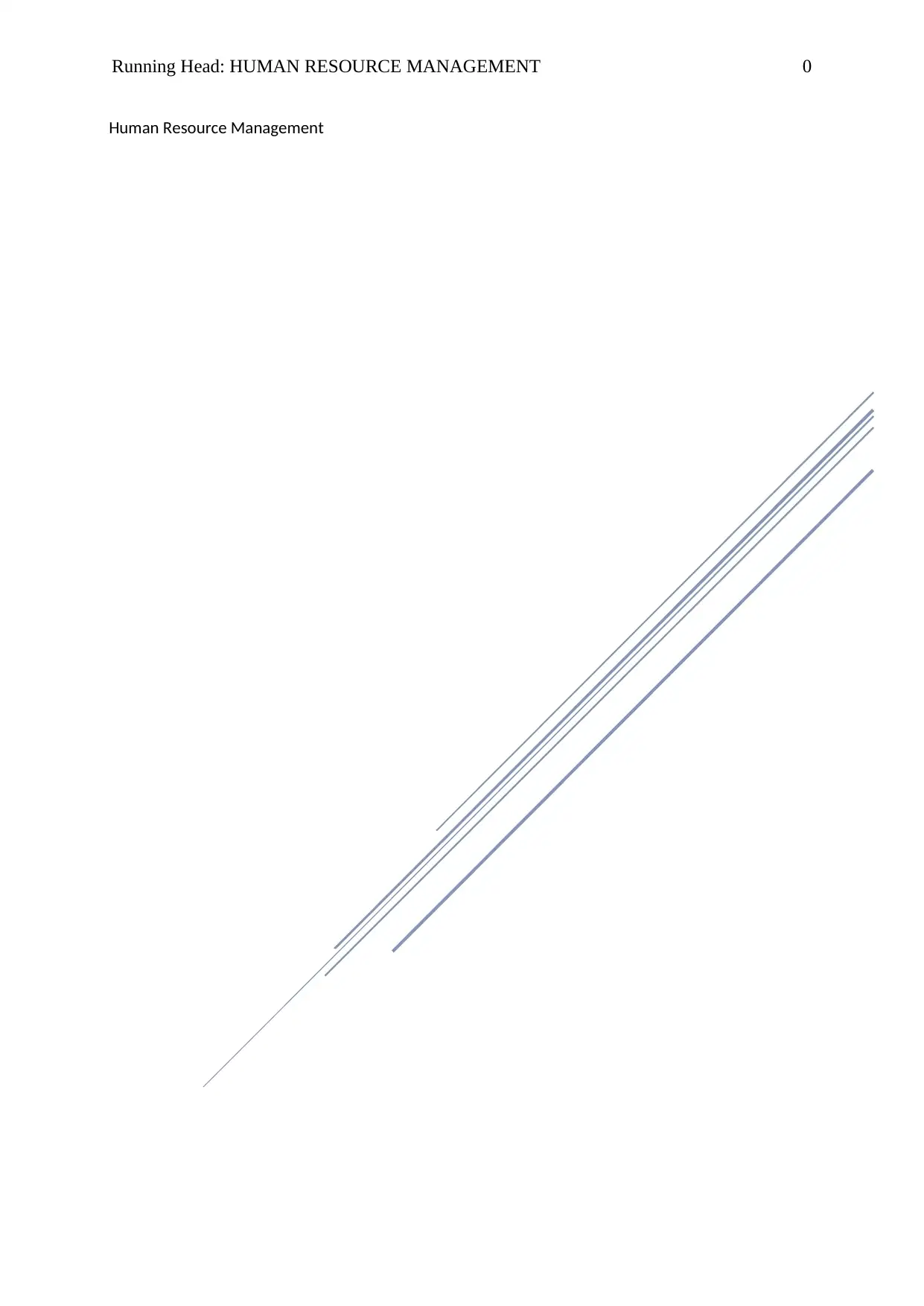
Running Head: HUMAN RESOURCE MANAGEMENT 0
Human Resource Management
Human Resource Management
Paraphrase This Document
Need a fresh take? Get an instant paraphrase of this document with our AI Paraphraser
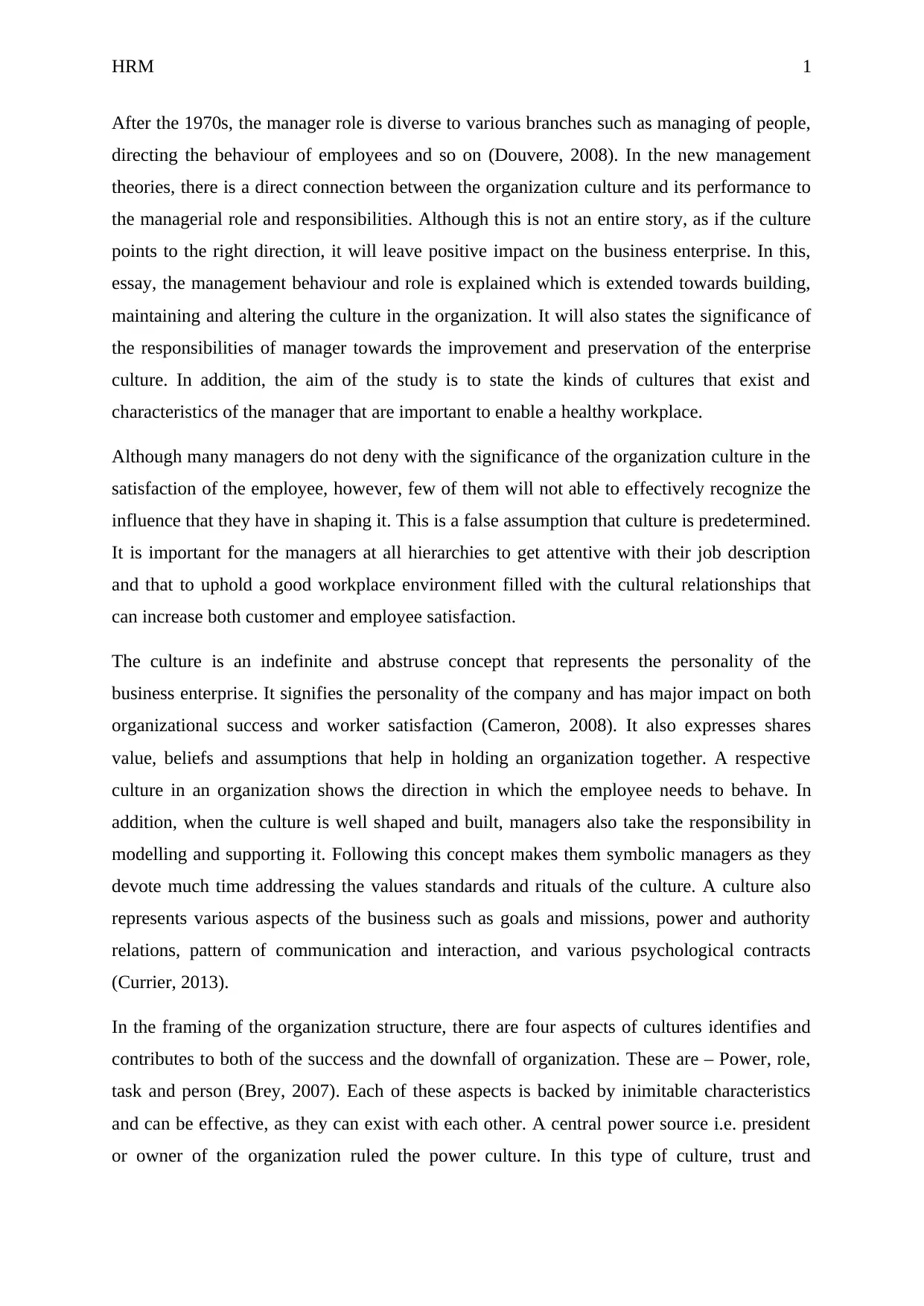
HRM 1
After the 1970s, the manager role is diverse to various branches such as managing of people,
directing the behaviour of employees and so on (Douvere, 2008). In the new management
theories, there is a direct connection between the organization culture and its performance to
the managerial role and responsibilities. Although this is not an entire story, as if the culture
points to the right direction, it will leave positive impact on the business enterprise. In this,
essay, the management behaviour and role is explained which is extended towards building,
maintaining and altering the culture in the organization. It will also states the significance of
the responsibilities of manager towards the improvement and preservation of the enterprise
culture. In addition, the aim of the study is to state the kinds of cultures that exist and
characteristics of the manager that are important to enable a healthy workplace.
Although many managers do not deny with the significance of the organization culture in the
satisfaction of the employee, however, few of them will not able to effectively recognize the
influence that they have in shaping it. This is a false assumption that culture is predetermined.
It is important for the managers at all hierarchies to get attentive with their job description
and that to uphold a good workplace environment filled with the cultural relationships that
can increase both customer and employee satisfaction.
The culture is an indefinite and abstruse concept that represents the personality of the
business enterprise. It signifies the personality of the company and has major impact on both
organizational success and worker satisfaction (Cameron, 2008). It also expresses shares
value, beliefs and assumptions that help in holding an organization together. A respective
culture in an organization shows the direction in which the employee needs to behave. In
addition, when the culture is well shaped and built, managers also take the responsibility in
modelling and supporting it. Following this concept makes them symbolic managers as they
devote much time addressing the values standards and rituals of the culture. A culture also
represents various aspects of the business such as goals and missions, power and authority
relations, pattern of communication and interaction, and various psychological contracts
(Currier, 2013).
In the framing of the organization structure, there are four aspects of cultures identifies and
contributes to both of the success and the downfall of organization. These are – Power, role,
task and person (Brey, 2007). Each of these aspects is backed by inimitable characteristics
and can be effective, as they can exist with each other. A central power source i.e. president
or owner of the organization ruled the power culture. In this type of culture, trust and
After the 1970s, the manager role is diverse to various branches such as managing of people,
directing the behaviour of employees and so on (Douvere, 2008). In the new management
theories, there is a direct connection between the organization culture and its performance to
the managerial role and responsibilities. Although this is not an entire story, as if the culture
points to the right direction, it will leave positive impact on the business enterprise. In this,
essay, the management behaviour and role is explained which is extended towards building,
maintaining and altering the culture in the organization. It will also states the significance of
the responsibilities of manager towards the improvement and preservation of the enterprise
culture. In addition, the aim of the study is to state the kinds of cultures that exist and
characteristics of the manager that are important to enable a healthy workplace.
Although many managers do not deny with the significance of the organization culture in the
satisfaction of the employee, however, few of them will not able to effectively recognize the
influence that they have in shaping it. This is a false assumption that culture is predetermined.
It is important for the managers at all hierarchies to get attentive with their job description
and that to uphold a good workplace environment filled with the cultural relationships that
can increase both customer and employee satisfaction.
The culture is an indefinite and abstruse concept that represents the personality of the
business enterprise. It signifies the personality of the company and has major impact on both
organizational success and worker satisfaction (Cameron, 2008). It also expresses shares
value, beliefs and assumptions that help in holding an organization together. A respective
culture in an organization shows the direction in which the employee needs to behave. In
addition, when the culture is well shaped and built, managers also take the responsibility in
modelling and supporting it. Following this concept makes them symbolic managers as they
devote much time addressing the values standards and rituals of the culture. A culture also
represents various aspects of the business such as goals and missions, power and authority
relations, pattern of communication and interaction, and various psychological contracts
(Currier, 2013).
In the framing of the organization structure, there are four aspects of cultures identifies and
contributes to both of the success and the downfall of organization. These are – Power, role,
task and person (Brey, 2007). Each of these aspects is backed by inimitable characteristics
and can be effective, as they can exist with each other. A central power source i.e. president
or owner of the organization ruled the power culture. In this type of culture, trust and
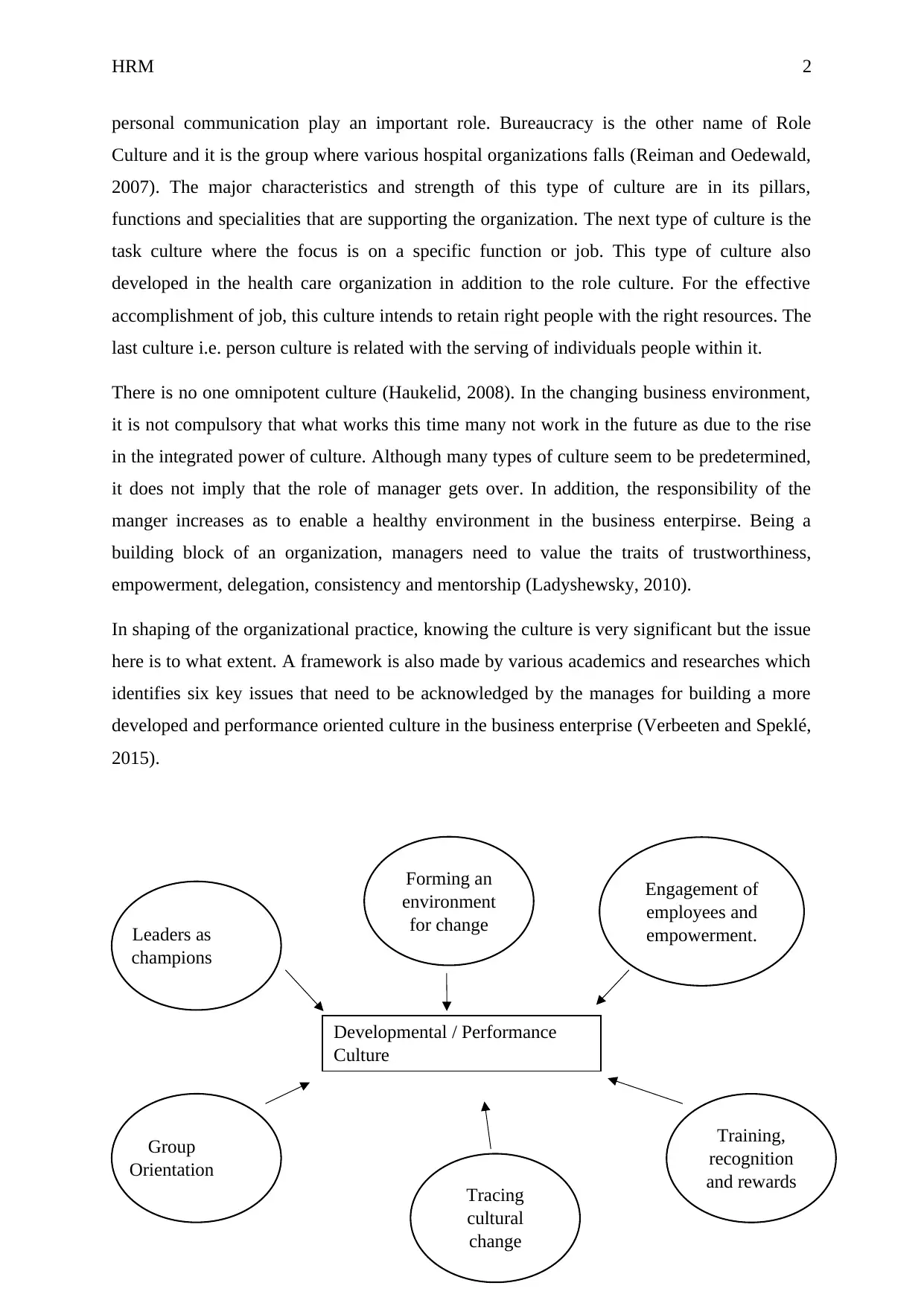
HRM 2
personal communication play an important role. Bureaucracy is the other name of Role
Culture and it is the group where various hospital organizations falls (Reiman and Oedewald,
2007). The major characteristics and strength of this type of culture are in its pillars,
functions and specialities that are supporting the organization. The next type of culture is the
task culture where the focus is on a specific function or job. This type of culture also
developed in the health care organization in addition to the role culture. For the effective
accomplishment of job, this culture intends to retain right people with the right resources. The
last culture i.e. person culture is related with the serving of individuals people within it.
There is no one omnipotent culture (Haukelid, 2008). In the changing business environment,
it is not compulsory that what works this time many not work in the future as due to the rise
in the integrated power of culture. Although many types of culture seem to be predetermined,
it does not imply that the role of manager gets over. In addition, the responsibility of the
manger increases as to enable a healthy environment in the business enterpirse. Being a
building block of an organization, managers need to value the traits of trustworthiness,
empowerment, delegation, consistency and mentorship (Ladyshewsky, 2010).
In shaping of the organizational practice, knowing the culture is very significant but the issue
here is to what extent. A framework is also made by various academics and researches which
identifies six key issues that need to be acknowledged by the manages for building a more
developed and performance oriented culture in the business enterprise (Verbeeten and Speklé,
2015).
Developmental / Performance
Culture
Engagement of
employees and
empowerment.Leaders as
champions
Forming an
environment
for change
Group
Orientation
Tracing
cultural
change
Training,
recognition
and rewards
personal communication play an important role. Bureaucracy is the other name of Role
Culture and it is the group where various hospital organizations falls (Reiman and Oedewald,
2007). The major characteristics and strength of this type of culture are in its pillars,
functions and specialities that are supporting the organization. The next type of culture is the
task culture where the focus is on a specific function or job. This type of culture also
developed in the health care organization in addition to the role culture. For the effective
accomplishment of job, this culture intends to retain right people with the right resources. The
last culture i.e. person culture is related with the serving of individuals people within it.
There is no one omnipotent culture (Haukelid, 2008). In the changing business environment,
it is not compulsory that what works this time many not work in the future as due to the rise
in the integrated power of culture. Although many types of culture seem to be predetermined,
it does not imply that the role of manager gets over. In addition, the responsibility of the
manger increases as to enable a healthy environment in the business enterpirse. Being a
building block of an organization, managers need to value the traits of trustworthiness,
empowerment, delegation, consistency and mentorship (Ladyshewsky, 2010).
In shaping of the organizational practice, knowing the culture is very significant but the issue
here is to what extent. A framework is also made by various academics and researches which
identifies six key issues that need to be acknowledged by the manages for building a more
developed and performance oriented culture in the business enterprise (Verbeeten and Speklé,
2015).
Developmental / Performance
Culture
Engagement of
employees and
empowerment.Leaders as
champions
Forming an
environment
for change
Group
Orientation
Tracing
cultural
change
Training,
recognition
and rewards
⊘ This is a preview!⊘
Do you want full access?
Subscribe today to unlock all pages.

Trusted by 1+ million students worldwide
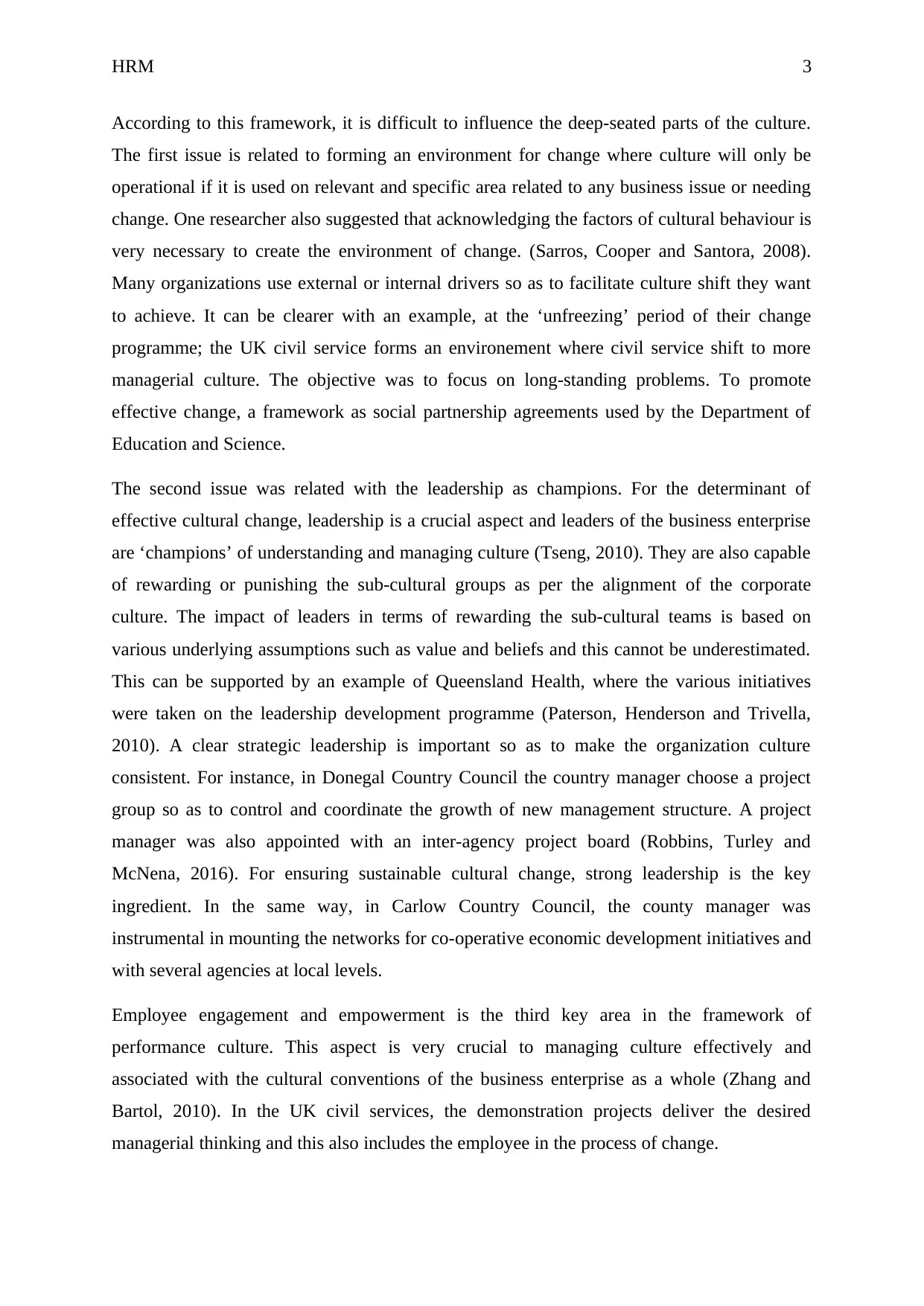
HRM 3
According to this framework, it is difficult to influence the deep-seated parts of the culture.
The first issue is related to forming an environment for change where culture will only be
operational if it is used on relevant and specific area related to any business issue or needing
change. One researcher also suggested that acknowledging the factors of cultural behaviour is
very necessary to create the environment of change. (Sarros, Cooper and Santora, 2008).
Many organizations use external or internal drivers so as to facilitate culture shift they want
to achieve. It can be clearer with an example, at the ‘unfreezing’ period of their change
programme; the UK civil service forms an environement where civil service shift to more
managerial culture. The objective was to focus on long-standing problems. To promote
effective change, a framework as social partnership agreements used by the Department of
Education and Science.
The second issue was related with the leadership as champions. For the determinant of
effective cultural change, leadership is a crucial aspect and leaders of the business enterprise
are ‘champions’ of understanding and managing culture (Tseng, 2010). They are also capable
of rewarding or punishing the sub-cultural groups as per the alignment of the corporate
culture. The impact of leaders in terms of rewarding the sub-cultural teams is based on
various underlying assumptions such as value and beliefs and this cannot be underestimated.
This can be supported by an example of Queensland Health, where the various initiatives
were taken on the leadership development programme (Paterson, Henderson and Trivella,
2010). A clear strategic leadership is important so as to make the organization culture
consistent. For instance, in Donegal Country Council the country manager choose a project
group so as to control and coordinate the growth of new management structure. A project
manager was also appointed with an inter-agency project board (Robbins, Turley and
McNena, 2016). For ensuring sustainable cultural change, strong leadership is the key
ingredient. In the same way, in Carlow Country Council, the county manager was
instrumental in mounting the networks for co-operative economic development initiatives and
with several agencies at local levels.
Employee engagement and empowerment is the third key area in the framework of
performance culture. This aspect is very crucial to managing culture effectively and
associated with the cultural conventions of the business enterprise as a whole (Zhang and
Bartol, 2010). In the UK civil services, the demonstration projects deliver the desired
managerial thinking and this also includes the employee in the process of change.
According to this framework, it is difficult to influence the deep-seated parts of the culture.
The first issue is related to forming an environment for change where culture will only be
operational if it is used on relevant and specific area related to any business issue or needing
change. One researcher also suggested that acknowledging the factors of cultural behaviour is
very necessary to create the environment of change. (Sarros, Cooper and Santora, 2008).
Many organizations use external or internal drivers so as to facilitate culture shift they want
to achieve. It can be clearer with an example, at the ‘unfreezing’ period of their change
programme; the UK civil service forms an environement where civil service shift to more
managerial culture. The objective was to focus on long-standing problems. To promote
effective change, a framework as social partnership agreements used by the Department of
Education and Science.
The second issue was related with the leadership as champions. For the determinant of
effective cultural change, leadership is a crucial aspect and leaders of the business enterprise
are ‘champions’ of understanding and managing culture (Tseng, 2010). They are also capable
of rewarding or punishing the sub-cultural groups as per the alignment of the corporate
culture. The impact of leaders in terms of rewarding the sub-cultural teams is based on
various underlying assumptions such as value and beliefs and this cannot be underestimated.
This can be supported by an example of Queensland Health, where the various initiatives
were taken on the leadership development programme (Paterson, Henderson and Trivella,
2010). A clear strategic leadership is important so as to make the organization culture
consistent. For instance, in Donegal Country Council the country manager choose a project
group so as to control and coordinate the growth of new management structure. A project
manager was also appointed with an inter-agency project board (Robbins, Turley and
McNena, 2016). For ensuring sustainable cultural change, strong leadership is the key
ingredient. In the same way, in Carlow Country Council, the county manager was
instrumental in mounting the networks for co-operative economic development initiatives and
with several agencies at local levels.
Employee engagement and empowerment is the third key area in the framework of
performance culture. This aspect is very crucial to managing culture effectively and
associated with the cultural conventions of the business enterprise as a whole (Zhang and
Bartol, 2010). In the UK civil services, the demonstration projects deliver the desired
managerial thinking and this also includes the employee in the process of change.
Paraphrase This Document
Need a fresh take? Get an instant paraphrase of this document with our AI Paraphraser
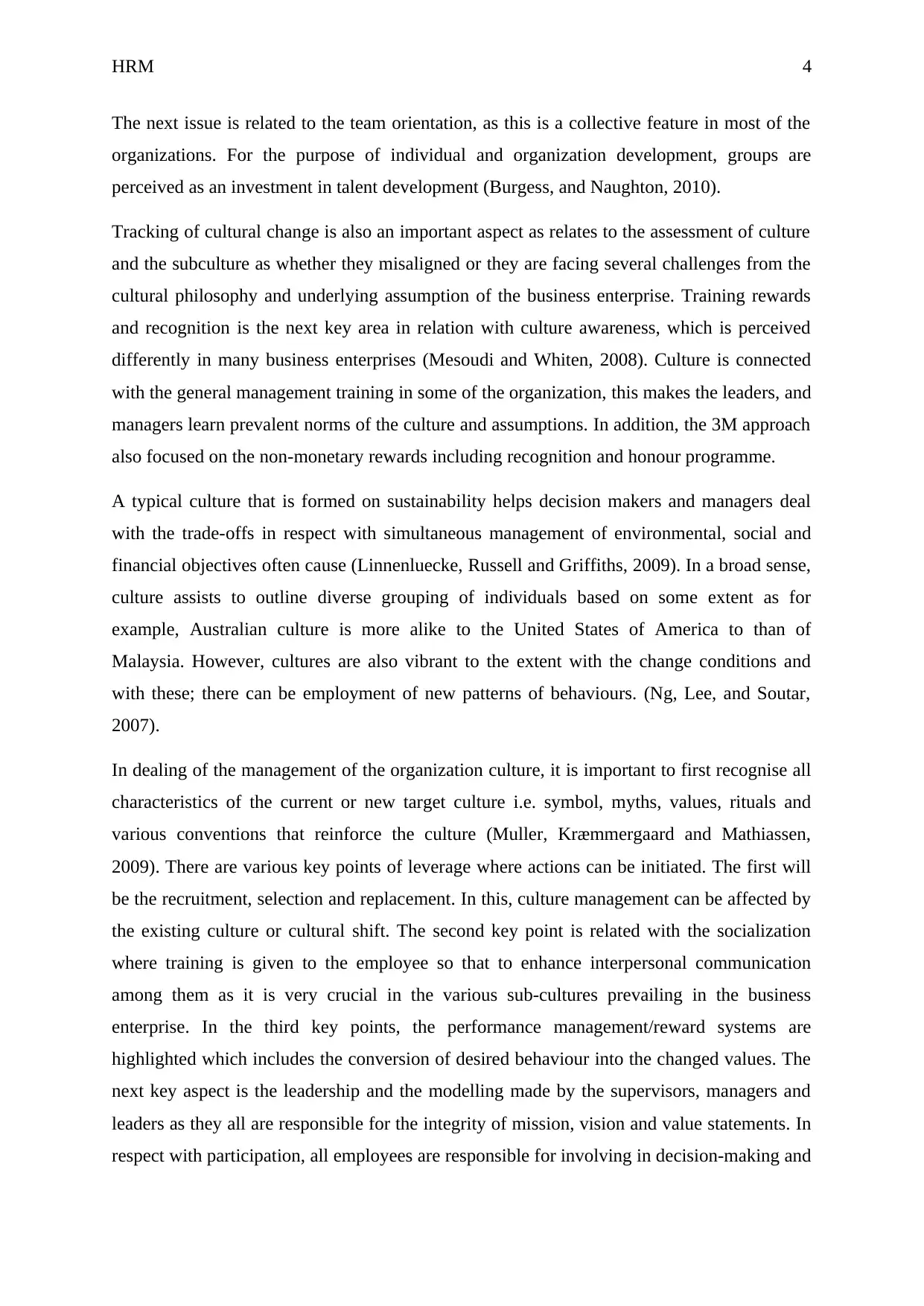
HRM 4
The next issue is related to the team orientation, as this is a collective feature in most of the
organizations. For the purpose of individual and organization development, groups are
perceived as an investment in talent development (Burgess, and Naughton, 2010).
Tracking of cultural change is also an important aspect as relates to the assessment of culture
and the subculture as whether they misaligned or they are facing several challenges from the
cultural philosophy and underlying assumption of the business enterprise. Training rewards
and recognition is the next key area in relation with culture awareness, which is perceived
differently in many business enterprises (Mesoudi and Whiten, 2008). Culture is connected
with the general management training in some of the organization, this makes the leaders, and
managers learn prevalent norms of the culture and assumptions. In addition, the 3M approach
also focused on the non-monetary rewards including recognition and honour programme.
A typical culture that is formed on sustainability helps decision makers and managers deal
with the trade-offs in respect with simultaneous management of environmental, social and
financial objectives often cause (Linnenluecke, Russell and Griffiths, 2009). In a broad sense,
culture assists to outline diverse grouping of individuals based on some extent as for
example, Australian culture is more alike to the United States of America to than of
Malaysia. However, cultures are also vibrant to the extent with the change conditions and
with these; there can be employment of new patterns of behaviours. (Ng, Lee, and Soutar,
2007).
In dealing of the management of the organization culture, it is important to first recognise all
characteristics of the current or new target culture i.e. symbol, myths, values, rituals and
various conventions that reinforce the culture (Muller, Kræmmergaard and Mathiassen,
2009). There are various key points of leverage where actions can be initiated. The first will
be the recruitment, selection and replacement. In this, culture management can be affected by
the existing culture or cultural shift. The second key point is related with the socialization
where training is given to the employee so that to enhance interpersonal communication
among them as it is very crucial in the various sub-cultures prevailing in the business
enterprise. In the third key points, the performance management/reward systems are
highlighted which includes the conversion of desired behaviour into the changed values. The
next key aspect is the leadership and the modelling made by the supervisors, managers and
leaders as they all are responsible for the integrity of mission, vision and value statements. In
respect with participation, all employees are responsible for involving in decision-making and
The next issue is related to the team orientation, as this is a collective feature in most of the
organizations. For the purpose of individual and organization development, groups are
perceived as an investment in talent development (Burgess, and Naughton, 2010).
Tracking of cultural change is also an important aspect as relates to the assessment of culture
and the subculture as whether they misaligned or they are facing several challenges from the
cultural philosophy and underlying assumption of the business enterprise. Training rewards
and recognition is the next key area in relation with culture awareness, which is perceived
differently in many business enterprises (Mesoudi and Whiten, 2008). Culture is connected
with the general management training in some of the organization, this makes the leaders, and
managers learn prevalent norms of the culture and assumptions. In addition, the 3M approach
also focused on the non-monetary rewards including recognition and honour programme.
A typical culture that is formed on sustainability helps decision makers and managers deal
with the trade-offs in respect with simultaneous management of environmental, social and
financial objectives often cause (Linnenluecke, Russell and Griffiths, 2009). In a broad sense,
culture assists to outline diverse grouping of individuals based on some extent as for
example, Australian culture is more alike to the United States of America to than of
Malaysia. However, cultures are also vibrant to the extent with the change conditions and
with these; there can be employment of new patterns of behaviours. (Ng, Lee, and Soutar,
2007).
In dealing of the management of the organization culture, it is important to first recognise all
characteristics of the current or new target culture i.e. symbol, myths, values, rituals and
various conventions that reinforce the culture (Muller, Kræmmergaard and Mathiassen,
2009). There are various key points of leverage where actions can be initiated. The first will
be the recruitment, selection and replacement. In this, culture management can be affected by
the existing culture or cultural shift. The second key point is related with the socialization
where training is given to the employee so that to enhance interpersonal communication
among them as it is very crucial in the various sub-cultures prevailing in the business
enterprise. In the third key points, the performance management/reward systems are
highlighted which includes the conversion of desired behaviour into the changed values. The
next key aspect is the leadership and the modelling made by the supervisors, managers and
leaders as they all are responsible for the integrity of mission, vision and value statements. In
respect with participation, all employees are responsible for involving in decision-making and
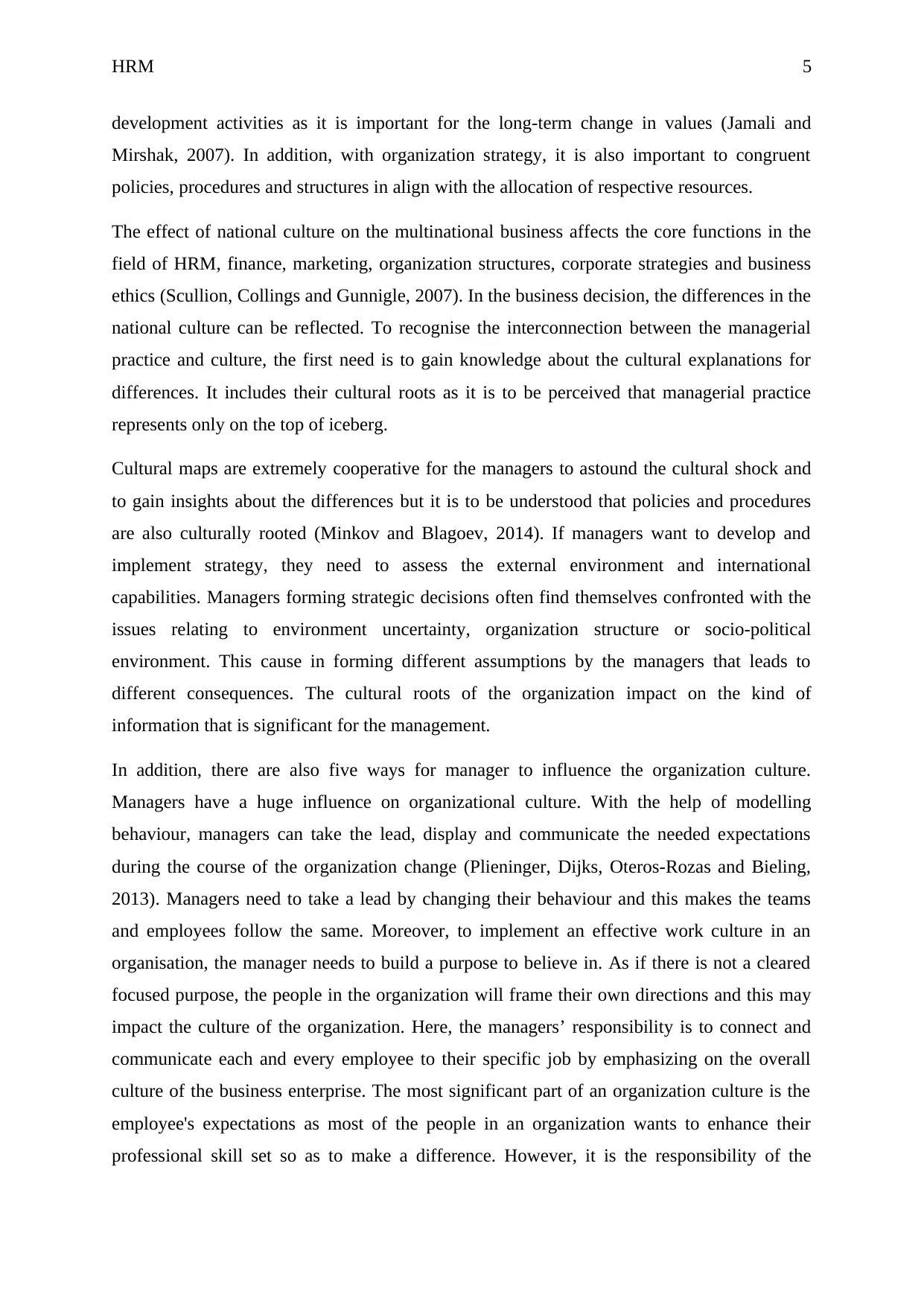
HRM 5
development activities as it is important for the long-term change in values (Jamali and
Mirshak, 2007). In addition, with organization strategy, it is also important to congruent
policies, procedures and structures in align with the allocation of respective resources.
The effect of national culture on the multinational business affects the core functions in the
field of HRM, finance, marketing, organization structures, corporate strategies and business
ethics (Scullion, Collings and Gunnigle, 2007). In the business decision, the differences in the
national culture can be reflected. To recognise the interconnection between the managerial
practice and culture, the first need is to gain knowledge about the cultural explanations for
differences. It includes their cultural roots as it is to be perceived that managerial practice
represents only on the top of iceberg.
Cultural maps are extremely cooperative for the managers to astound the cultural shock and
to gain insights about the differences but it is to be understood that policies and procedures
are also culturally rooted (Minkov and Blagoev, 2014). If managers want to develop and
implement strategy, they need to assess the external environment and international
capabilities. Managers forming strategic decisions often find themselves confronted with the
issues relating to environment uncertainty, organization structure or socio-political
environment. This cause in forming different assumptions by the managers that leads to
different consequences. The cultural roots of the organization impact on the kind of
information that is significant for the management.
In addition, there are also five ways for manager to influence the organization culture.
Managers have a huge influence on organizational culture. With the help of modelling
behaviour, managers can take the lead, display and communicate the needed expectations
during the course of the organization change (Plieninger, Dijks, Oteros-Rozas and Bieling,
2013). Managers need to take a lead by changing their behaviour and this makes the teams
and employees follow the same. Moreover, to implement an effective work culture in an
organisation, the manager needs to build a purpose to believe in. As if there is not a cleared
focused purpose, the people in the organization will frame their own directions and this may
impact the culture of the organization. Here, the managers’ responsibility is to connect and
communicate each and every employee to their specific job by emphasizing on the overall
culture of the business enterprise. The most significant part of an organization culture is the
employee's expectations as most of the people in an organization wants to enhance their
professional skill set so as to make a difference. However, it is the responsibility of the
development activities as it is important for the long-term change in values (Jamali and
Mirshak, 2007). In addition, with organization strategy, it is also important to congruent
policies, procedures and structures in align with the allocation of respective resources.
The effect of national culture on the multinational business affects the core functions in the
field of HRM, finance, marketing, organization structures, corporate strategies and business
ethics (Scullion, Collings and Gunnigle, 2007). In the business decision, the differences in the
national culture can be reflected. To recognise the interconnection between the managerial
practice and culture, the first need is to gain knowledge about the cultural explanations for
differences. It includes their cultural roots as it is to be perceived that managerial practice
represents only on the top of iceberg.
Cultural maps are extremely cooperative for the managers to astound the cultural shock and
to gain insights about the differences but it is to be understood that policies and procedures
are also culturally rooted (Minkov and Blagoev, 2014). If managers want to develop and
implement strategy, they need to assess the external environment and international
capabilities. Managers forming strategic decisions often find themselves confronted with the
issues relating to environment uncertainty, organization structure or socio-political
environment. This cause in forming different assumptions by the managers that leads to
different consequences. The cultural roots of the organization impact on the kind of
information that is significant for the management.
In addition, there are also five ways for manager to influence the organization culture.
Managers have a huge influence on organizational culture. With the help of modelling
behaviour, managers can take the lead, display and communicate the needed expectations
during the course of the organization change (Plieninger, Dijks, Oteros-Rozas and Bieling,
2013). Managers need to take a lead by changing their behaviour and this makes the teams
and employees follow the same. Moreover, to implement an effective work culture in an
organisation, the manager needs to build a purpose to believe in. As if there is not a cleared
focused purpose, the people in the organization will frame their own directions and this may
impact the culture of the organization. Here, the managers’ responsibility is to connect and
communicate each and every employee to their specific job by emphasizing on the overall
culture of the business enterprise. The most significant part of an organization culture is the
employee's expectations as most of the people in an organization wants to enhance their
professional skill set so as to make a difference. However, it is the responsibility of the
⊘ This is a preview!⊘
Do you want full access?
Subscribe today to unlock all pages.

Trusted by 1+ million students worldwide
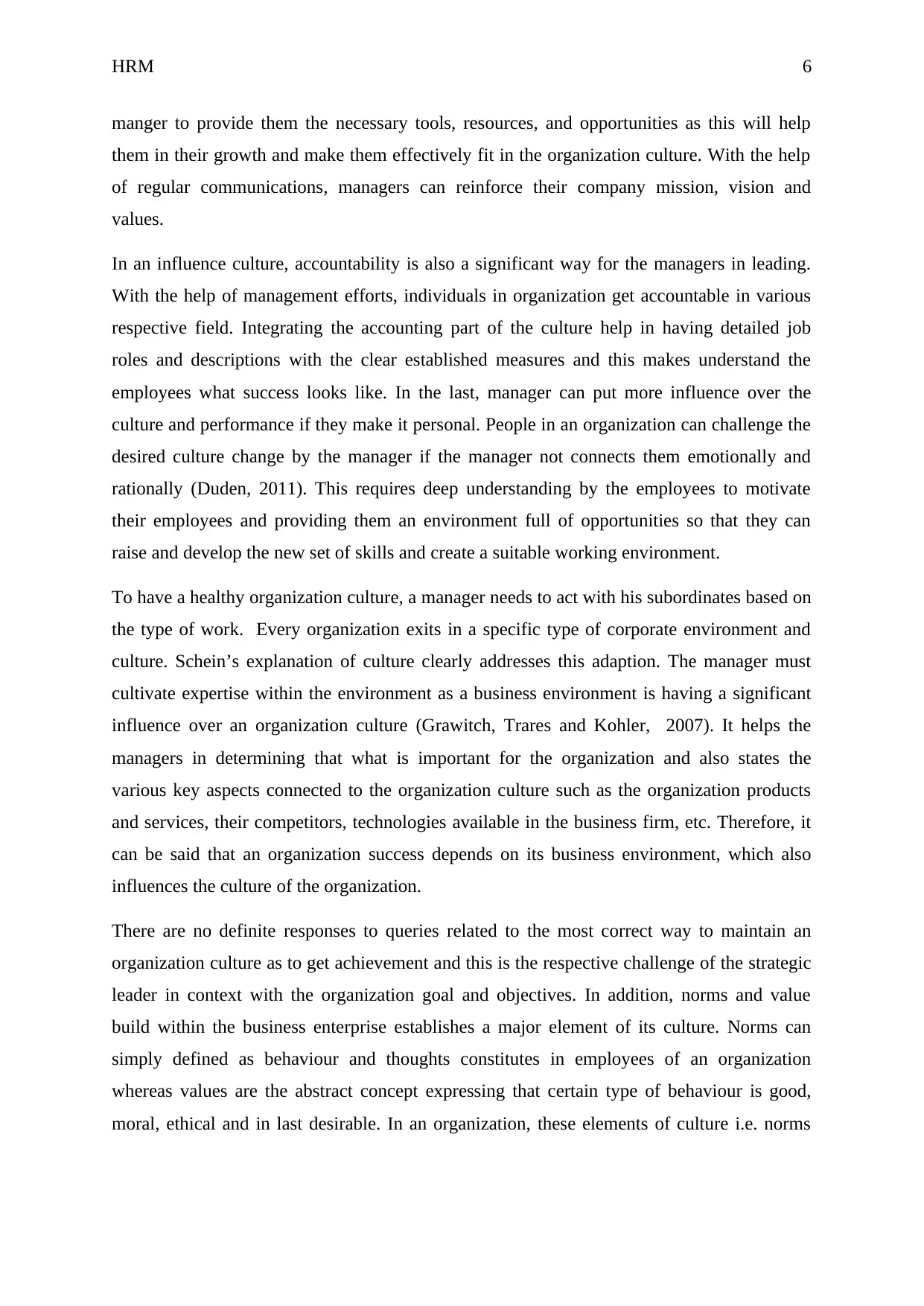
HRM 6
manger to provide them the necessary tools, resources, and opportunities as this will help
them in their growth and make them effectively fit in the organization culture. With the help
of regular communications, managers can reinforce their company mission, vision and
values.
In an influence culture, accountability is also a significant way for the managers in leading.
With the help of management efforts, individuals in organization get accountable in various
respective field. Integrating the accounting part of the culture help in having detailed job
roles and descriptions with the clear established measures and this makes understand the
employees what success looks like. In the last, manager can put more influence over the
culture and performance if they make it personal. People in an organization can challenge the
desired culture change by the manager if the manager not connects them emotionally and
rationally (Duden, 2011). This requires deep understanding by the employees to motivate
their employees and providing them an environment full of opportunities so that they can
raise and develop the new set of skills and create a suitable working environment.
To have a healthy organization culture, a manager needs to act with his subordinates based on
the type of work. Every organization exits in a specific type of corporate environment and
culture. Schein’s explanation of culture clearly addresses this adaption. The manager must
cultivate expertise within the environment as a business environment is having a significant
influence over an organization culture (Grawitch, Trares and Kohler, 2007). It helps the
managers in determining that what is important for the organization and also states the
various key aspects connected to the organization culture such as the organization products
and services, their competitors, technologies available in the business firm, etc. Therefore, it
can be said that an organization success depends on its business environment, which also
influences the culture of the organization.
There are no definite responses to queries related to the most correct way to maintain an
organization culture as to get achievement and this is the respective challenge of the strategic
leader in context with the organization goal and objectives. In addition, norms and value
build within the business enterprise establishes a major element of its culture. Norms can
simply defined as behaviour and thoughts constitutes in employees of an organization
whereas values are the abstract concept expressing that certain type of behaviour is good,
moral, ethical and in last desirable. In an organization, these elements of culture i.e. norms
manger to provide them the necessary tools, resources, and opportunities as this will help
them in their growth and make them effectively fit in the organization culture. With the help
of regular communications, managers can reinforce their company mission, vision and
values.
In an influence culture, accountability is also a significant way for the managers in leading.
With the help of management efforts, individuals in organization get accountable in various
respective field. Integrating the accounting part of the culture help in having detailed job
roles and descriptions with the clear established measures and this makes understand the
employees what success looks like. In the last, manager can put more influence over the
culture and performance if they make it personal. People in an organization can challenge the
desired culture change by the manager if the manager not connects them emotionally and
rationally (Duden, 2011). This requires deep understanding by the employees to motivate
their employees and providing them an environment full of opportunities so that they can
raise and develop the new set of skills and create a suitable working environment.
To have a healthy organization culture, a manager needs to act with his subordinates based on
the type of work. Every organization exits in a specific type of corporate environment and
culture. Schein’s explanation of culture clearly addresses this adaption. The manager must
cultivate expertise within the environment as a business environment is having a significant
influence over an organization culture (Grawitch, Trares and Kohler, 2007). It helps the
managers in determining that what is important for the organization and also states the
various key aspects connected to the organization culture such as the organization products
and services, their competitors, technologies available in the business firm, etc. Therefore, it
can be said that an organization success depends on its business environment, which also
influences the culture of the organization.
There are no definite responses to queries related to the most correct way to maintain an
organization culture as to get achievement and this is the respective challenge of the strategic
leader in context with the organization goal and objectives. In addition, norms and value
build within the business enterprise establishes a major element of its culture. Norms can
simply defined as behaviour and thoughts constitutes in employees of an organization
whereas values are the abstract concept expressing that certain type of behaviour is good,
moral, ethical and in last desirable. In an organization, these elements of culture i.e. norms
Paraphrase This Document
Need a fresh take? Get an instant paraphrase of this document with our AI Paraphraser
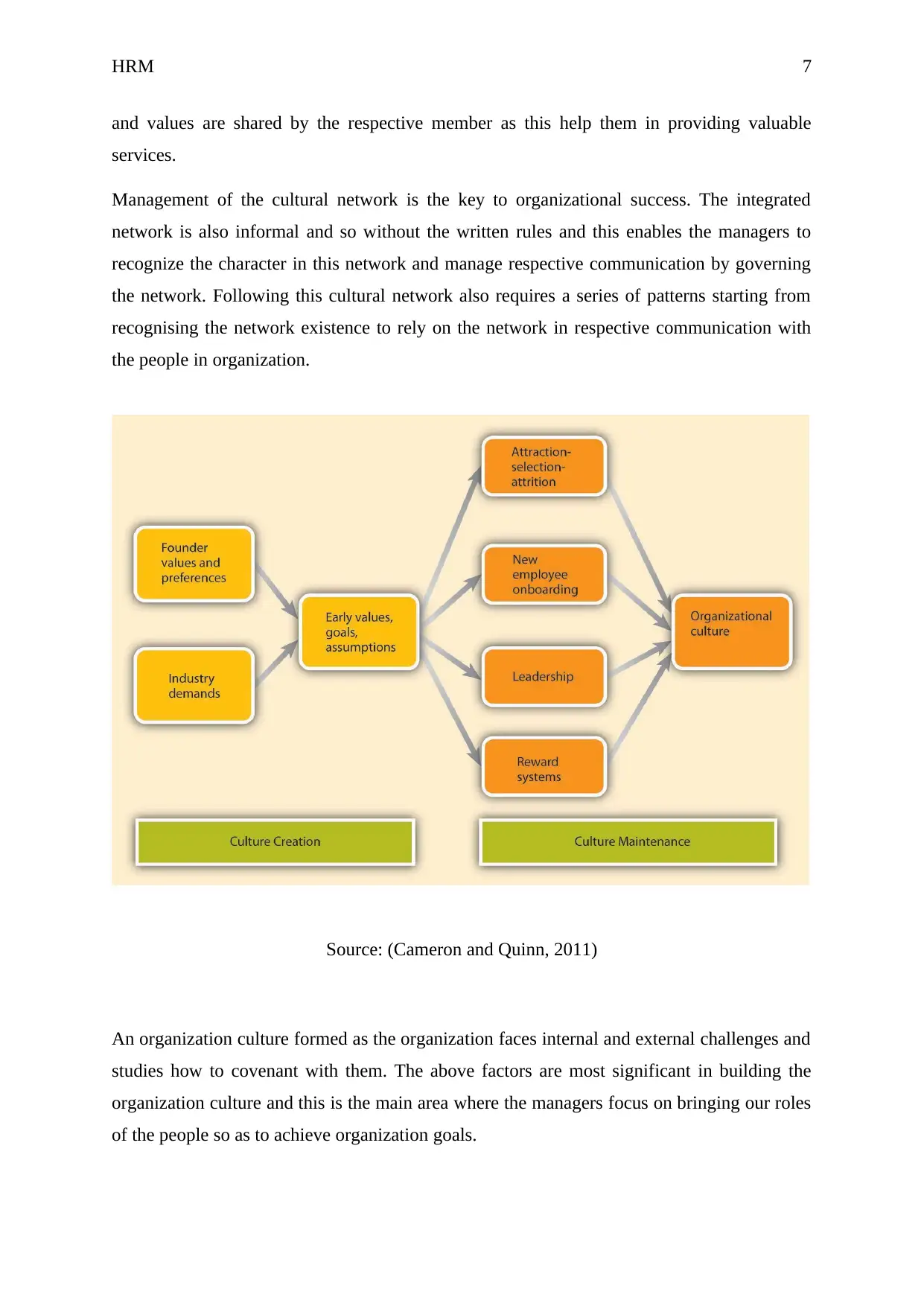
HRM 7
and values are shared by the respective member as this help them in providing valuable
services.
Management of the cultural network is the key to organizational success. The integrated
network is also informal and so without the written rules and this enables the managers to
recognize the character in this network and manage respective communication by governing
the network. Following this cultural network also requires a series of patterns starting from
recognising the network existence to rely on the network in respective communication with
the people in organization.
Source: (Cameron and Quinn, 2011)
An organization culture formed as the organization faces internal and external challenges and
studies how to covenant with them. The above factors are most significant in building the
organization culture and this is the main area where the managers focus on bringing our roles
of the people so as to achieve organization goals.
and values are shared by the respective member as this help them in providing valuable
services.
Management of the cultural network is the key to organizational success. The integrated
network is also informal and so without the written rules and this enables the managers to
recognize the character in this network and manage respective communication by governing
the network. Following this cultural network also requires a series of patterns starting from
recognising the network existence to rely on the network in respective communication with
the people in organization.
Source: (Cameron and Quinn, 2011)
An organization culture formed as the organization faces internal and external challenges and
studies how to covenant with them. The above factors are most significant in building the
organization culture and this is the main area where the managers focus on bringing our roles
of the people so as to achieve organization goals.
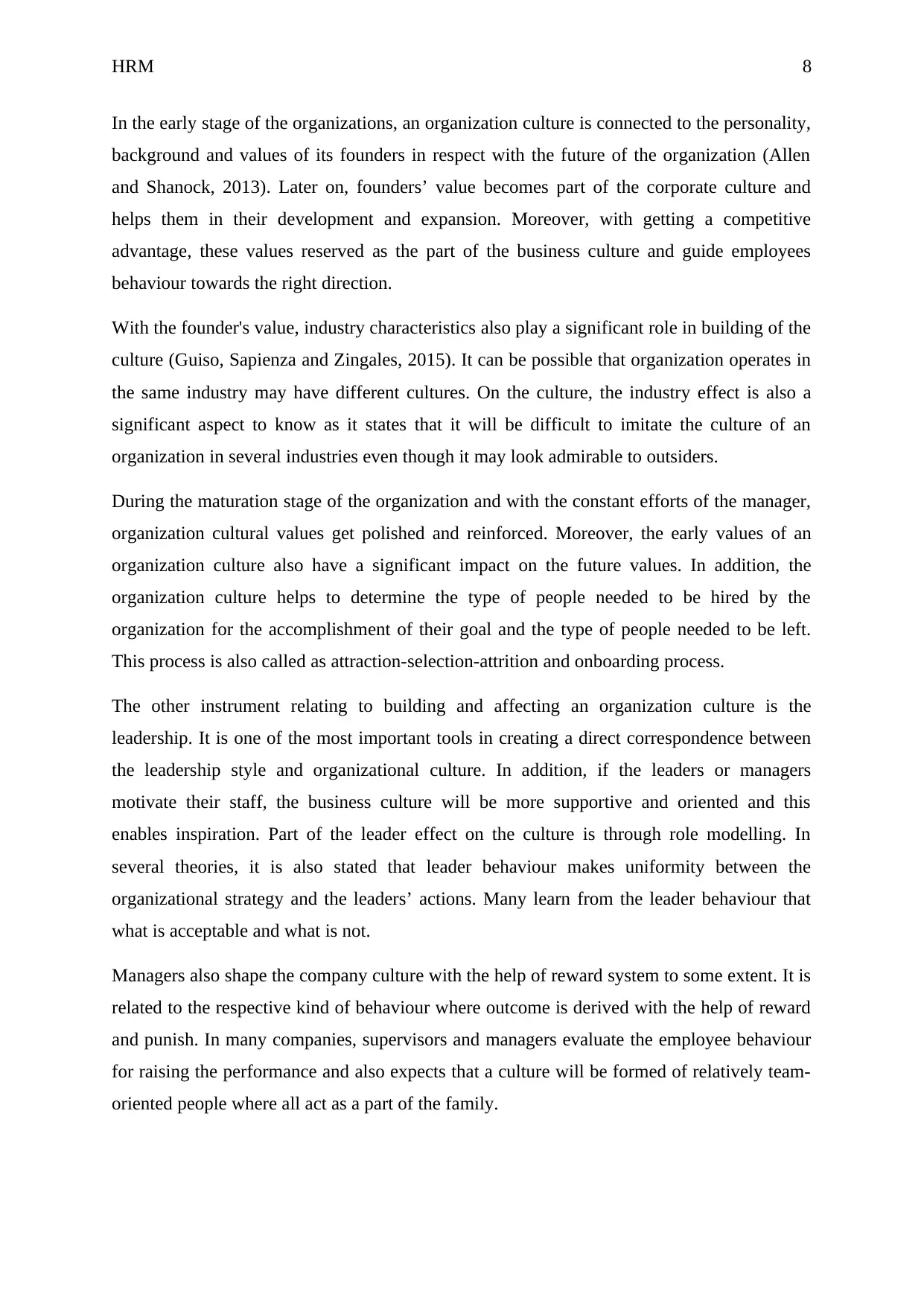
HRM 8
In the early stage of the organizations, an organization culture is connected to the personality,
background and values of its founders in respect with the future of the organization (Allen
and Shanock, 2013). Later on, founders’ value becomes part of the corporate culture and
helps them in their development and expansion. Moreover, with getting a competitive
advantage, these values reserved as the part of the business culture and guide employees
behaviour towards the right direction.
With the founder's value, industry characteristics also play a significant role in building of the
culture (Guiso, Sapienza and Zingales, 2015). It can be possible that organization operates in
the same industry may have different cultures. On the culture, the industry effect is also a
significant aspect to know as it states that it will be difficult to imitate the culture of an
organization in several industries even though it may look admirable to outsiders.
During the maturation stage of the organization and with the constant efforts of the manager,
organization cultural values get polished and reinforced. Moreover, the early values of an
organization culture also have a significant impact on the future values. In addition, the
organization culture helps to determine the type of people needed to be hired by the
organization for the accomplishment of their goal and the type of people needed to be left.
This process is also called as attraction-selection-attrition and onboarding process.
The other instrument relating to building and affecting an organization culture is the
leadership. It is one of the most important tools in creating a direct correspondence between
the leadership style and organizational culture. In addition, if the leaders or managers
motivate their staff, the business culture will be more supportive and oriented and this
enables inspiration. Part of the leader effect on the culture is through role modelling. In
several theories, it is also stated that leader behaviour makes uniformity between the
organizational strategy and the leaders’ actions. Many learn from the leader behaviour that
what is acceptable and what is not.
Managers also shape the company culture with the help of reward system to some extent. It is
related to the respective kind of behaviour where outcome is derived with the help of reward
and punish. In many companies, supervisors and managers evaluate the employee behaviour
for raising the performance and also expects that a culture will be formed of relatively team-
oriented people where all act as a part of the family.
In the early stage of the organizations, an organization culture is connected to the personality,
background and values of its founders in respect with the future of the organization (Allen
and Shanock, 2013). Later on, founders’ value becomes part of the corporate culture and
helps them in their development and expansion. Moreover, with getting a competitive
advantage, these values reserved as the part of the business culture and guide employees
behaviour towards the right direction.
With the founder's value, industry characteristics also play a significant role in building of the
culture (Guiso, Sapienza and Zingales, 2015). It can be possible that organization operates in
the same industry may have different cultures. On the culture, the industry effect is also a
significant aspect to know as it states that it will be difficult to imitate the culture of an
organization in several industries even though it may look admirable to outsiders.
During the maturation stage of the organization and with the constant efforts of the manager,
organization cultural values get polished and reinforced. Moreover, the early values of an
organization culture also have a significant impact on the future values. In addition, the
organization culture helps to determine the type of people needed to be hired by the
organization for the accomplishment of their goal and the type of people needed to be left.
This process is also called as attraction-selection-attrition and onboarding process.
The other instrument relating to building and affecting an organization culture is the
leadership. It is one of the most important tools in creating a direct correspondence between
the leadership style and organizational culture. In addition, if the leaders or managers
motivate their staff, the business culture will be more supportive and oriented and this
enables inspiration. Part of the leader effect on the culture is through role modelling. In
several theories, it is also stated that leader behaviour makes uniformity between the
organizational strategy and the leaders’ actions. Many learn from the leader behaviour that
what is acceptable and what is not.
Managers also shape the company culture with the help of reward system to some extent. It is
related to the respective kind of behaviour where outcome is derived with the help of reward
and punish. In many companies, supervisors and managers evaluate the employee behaviour
for raising the performance and also expects that a culture will be formed of relatively team-
oriented people where all act as a part of the family.
⊘ This is a preview!⊘
Do you want full access?
Subscribe today to unlock all pages.

Trusted by 1+ million students worldwide
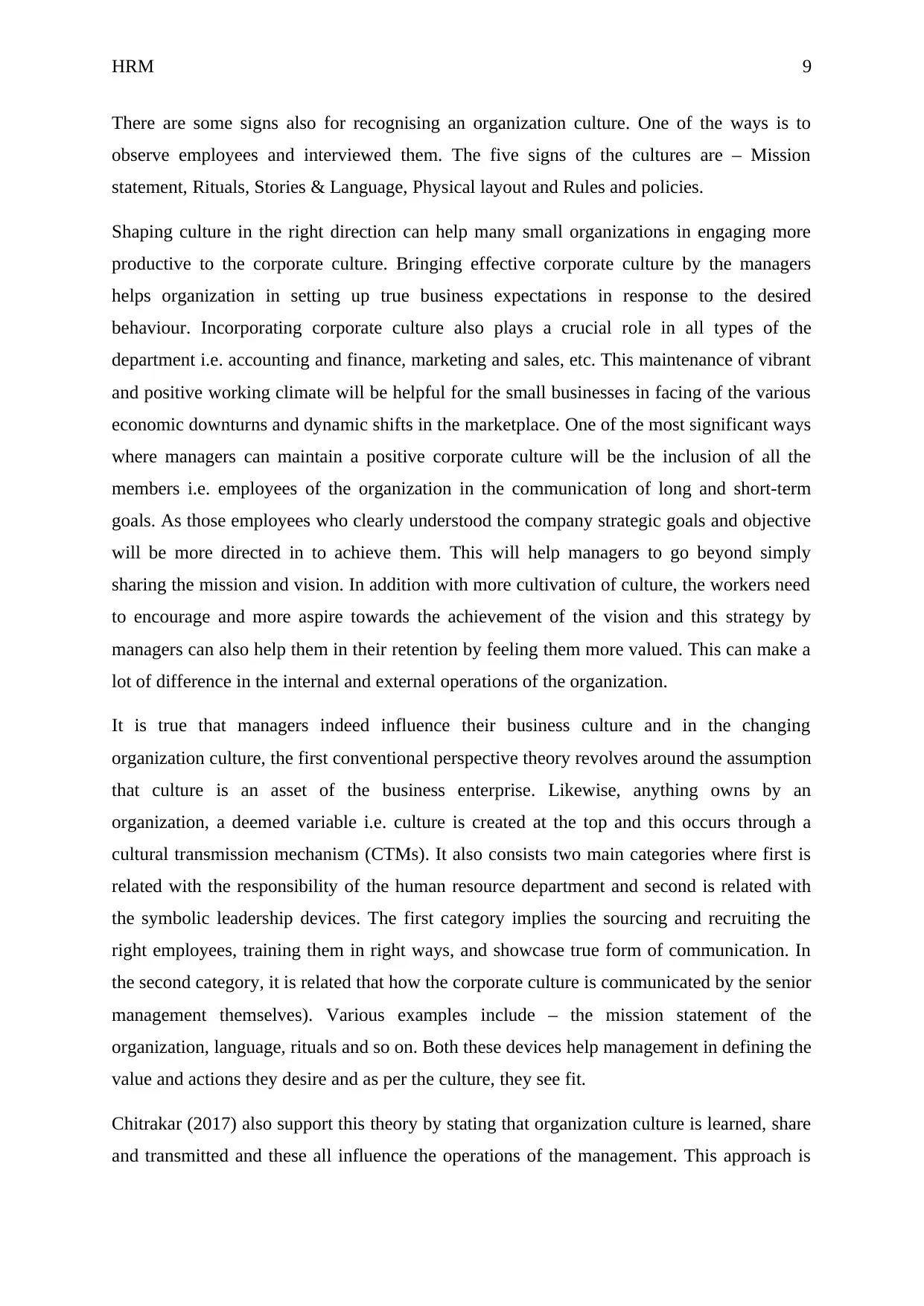
HRM 9
There are some signs also for recognising an organization culture. One of the ways is to
observe employees and interviewed them. The five signs of the cultures are – Mission
statement, Rituals, Stories & Language, Physical layout and Rules and policies.
Shaping culture in the right direction can help many small organizations in engaging more
productive to the corporate culture. Bringing effective corporate culture by the managers
helps organization in setting up true business expectations in response to the desired
behaviour. Incorporating corporate culture also plays a crucial role in all types of the
department i.e. accounting and finance, marketing and sales, etc. This maintenance of vibrant
and positive working climate will be helpful for the small businesses in facing of the various
economic downturns and dynamic shifts in the marketplace. One of the most significant ways
where managers can maintain a positive corporate culture will be the inclusion of all the
members i.e. employees of the organization in the communication of long and short-term
goals. As those employees who clearly understood the company strategic goals and objective
will be more directed in to achieve them. This will help managers to go beyond simply
sharing the mission and vision. In addition with more cultivation of culture, the workers need
to encourage and more aspire towards the achievement of the vision and this strategy by
managers can also help them in their retention by feeling them more valued. This can make a
lot of difference in the internal and external operations of the organization.
It is true that managers indeed influence their business culture and in the changing
organization culture, the first conventional perspective theory revolves around the assumption
that culture is an asset of the business enterprise. Likewise, anything owns by an
organization, a deemed variable i.e. culture is created at the top and this occurs through a
cultural transmission mechanism (CTMs). It also consists two main categories where first is
related with the responsibility of the human resource department and second is related with
the symbolic leadership devices. The first category implies the sourcing and recruiting the
right employees, training them in right ways, and showcase true form of communication. In
the second category, it is related that how the corporate culture is communicated by the senior
management themselves). Various examples include – the mission statement of the
organization, language, rituals and so on. Both these devices help management in defining the
value and actions they desire and as per the culture, they see fit.
Chitrakar (2017) also support this theory by stating that organization culture is learned, share
and transmitted and these all influence the operations of the management. This approach is
There are some signs also for recognising an organization culture. One of the ways is to
observe employees and interviewed them. The five signs of the cultures are – Mission
statement, Rituals, Stories & Language, Physical layout and Rules and policies.
Shaping culture in the right direction can help many small organizations in engaging more
productive to the corporate culture. Bringing effective corporate culture by the managers
helps organization in setting up true business expectations in response to the desired
behaviour. Incorporating corporate culture also plays a crucial role in all types of the
department i.e. accounting and finance, marketing and sales, etc. This maintenance of vibrant
and positive working climate will be helpful for the small businesses in facing of the various
economic downturns and dynamic shifts in the marketplace. One of the most significant ways
where managers can maintain a positive corporate culture will be the inclusion of all the
members i.e. employees of the organization in the communication of long and short-term
goals. As those employees who clearly understood the company strategic goals and objective
will be more directed in to achieve them. This will help managers to go beyond simply
sharing the mission and vision. In addition with more cultivation of culture, the workers need
to encourage and more aspire towards the achievement of the vision and this strategy by
managers can also help them in their retention by feeling them more valued. This can make a
lot of difference in the internal and external operations of the organization.
It is true that managers indeed influence their business culture and in the changing
organization culture, the first conventional perspective theory revolves around the assumption
that culture is an asset of the business enterprise. Likewise, anything owns by an
organization, a deemed variable i.e. culture is created at the top and this occurs through a
cultural transmission mechanism (CTMs). It also consists two main categories where first is
related with the responsibility of the human resource department and second is related with
the symbolic leadership devices. The first category implies the sourcing and recruiting the
right employees, training them in right ways, and showcase true form of communication. In
the second category, it is related that how the corporate culture is communicated by the senior
management themselves). Various examples include – the mission statement of the
organization, language, rituals and so on. Both these devices help management in defining the
value and actions they desire and as per the culture, they see fit.
Chitrakar (2017) also support this theory by stating that organization culture is learned, share
and transmitted and these all influence the operations of the management. This approach is
Paraphrase This Document
Need a fresh take? Get an instant paraphrase of this document with our AI Paraphraser
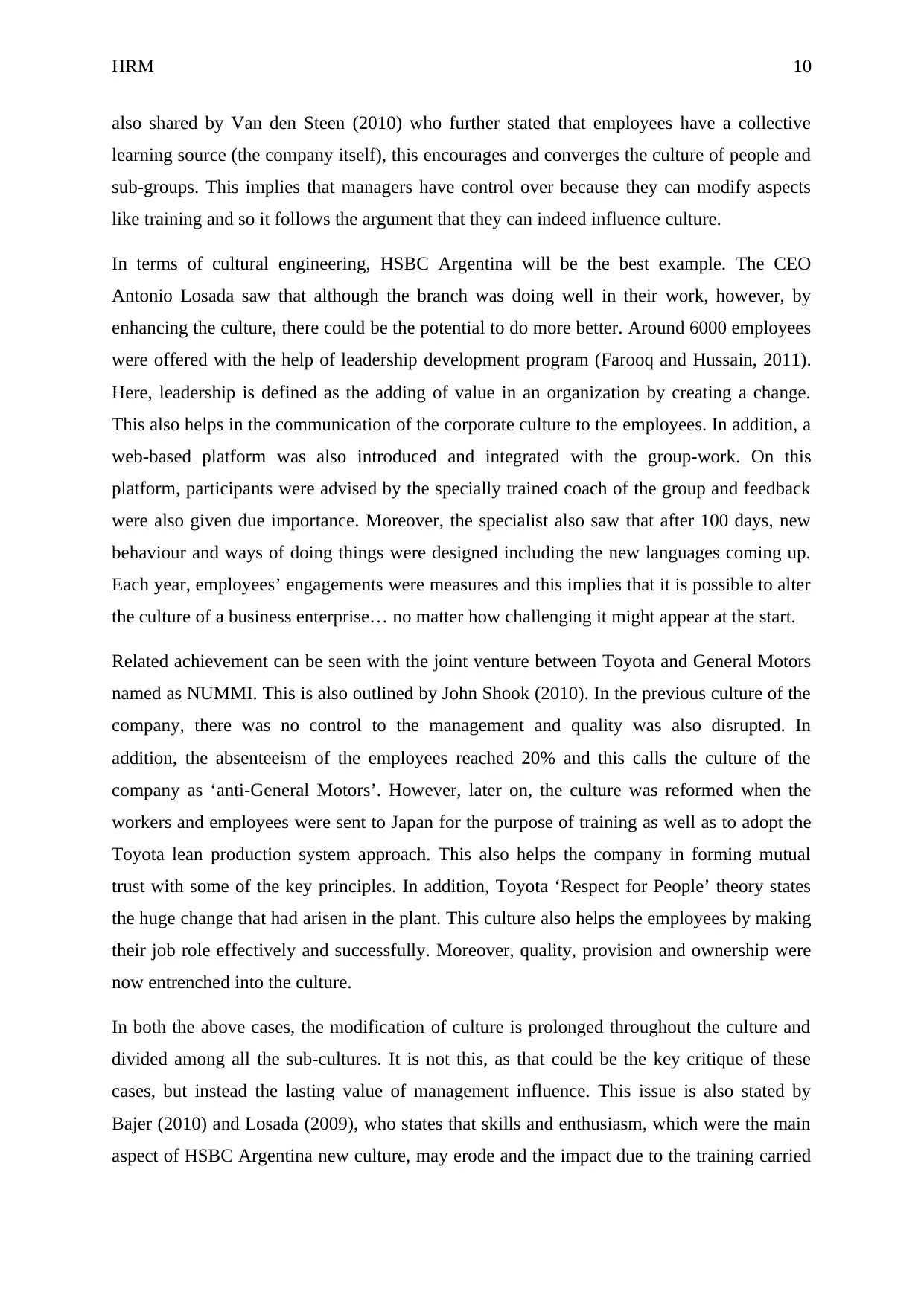
HRM 10
also shared by Van den Steen (2010) who further stated that employees have a collective
learning source (the company itself), this encourages and converges the culture of people and
sub-groups. This implies that managers have control over because they can modify aspects
like training and so it follows the argument that they can indeed influence culture.
In terms of cultural engineering, HSBC Argentina will be the best example. The CEO
Antonio Losada saw that although the branch was doing well in their work, however, by
enhancing the culture, there could be the potential to do more better. Around 6000 employees
were offered with the help of leadership development program (Farooq and Hussain, 2011).
Here, leadership is defined as the adding of value in an organization by creating a change.
This also helps in the communication of the corporate culture to the employees. In addition, a
web-based platform was also introduced and integrated with the group-work. On this
platform, participants were advised by the specially trained coach of the group and feedback
were also given due importance. Moreover, the specialist also saw that after 100 days, new
behaviour and ways of doing things were designed including the new languages coming up.
Each year, employees’ engagements were measures and this implies that it is possible to alter
the culture of a business enterprise… no matter how challenging it might appear at the start.
Related achievement can be seen with the joint venture between Toyota and General Motors
named as NUMMI. This is also outlined by John Shook (2010). In the previous culture of the
company, there was no control to the management and quality was also disrupted. In
addition, the absenteeism of the employees reached 20% and this calls the culture of the
company as ‘anti-General Motors’. However, later on, the culture was reformed when the
workers and employees were sent to Japan for the purpose of training as well as to adopt the
Toyota lean production system approach. This also helps the company in forming mutual
trust with some of the key principles. In addition, Toyota ‘Respect for People’ theory states
the huge change that had arisen in the plant. This culture also helps the employees by making
their job role effectively and successfully. Moreover, quality, provision and ownership were
now entrenched into the culture.
In both the above cases, the modification of culture is prolonged throughout the culture and
divided among all the sub-cultures. It is not this, as that could be the key critique of these
cases, but instead the lasting value of management influence. This issue is also stated by
Bajer (2010) and Losada (2009), who states that skills and enthusiasm, which were the main
aspect of HSBC Argentina new culture, may erode and the impact due to the training carried
also shared by Van den Steen (2010) who further stated that employees have a collective
learning source (the company itself), this encourages and converges the culture of people and
sub-groups. This implies that managers have control over because they can modify aspects
like training and so it follows the argument that they can indeed influence culture.
In terms of cultural engineering, HSBC Argentina will be the best example. The CEO
Antonio Losada saw that although the branch was doing well in their work, however, by
enhancing the culture, there could be the potential to do more better. Around 6000 employees
were offered with the help of leadership development program (Farooq and Hussain, 2011).
Here, leadership is defined as the adding of value in an organization by creating a change.
This also helps in the communication of the corporate culture to the employees. In addition, a
web-based platform was also introduced and integrated with the group-work. On this
platform, participants were advised by the specially trained coach of the group and feedback
were also given due importance. Moreover, the specialist also saw that after 100 days, new
behaviour and ways of doing things were designed including the new languages coming up.
Each year, employees’ engagements were measures and this implies that it is possible to alter
the culture of a business enterprise… no matter how challenging it might appear at the start.
Related achievement can be seen with the joint venture between Toyota and General Motors
named as NUMMI. This is also outlined by John Shook (2010). In the previous culture of the
company, there was no control to the management and quality was also disrupted. In
addition, the absenteeism of the employees reached 20% and this calls the culture of the
company as ‘anti-General Motors’. However, later on, the culture was reformed when the
workers and employees were sent to Japan for the purpose of training as well as to adopt the
Toyota lean production system approach. This also helps the company in forming mutual
trust with some of the key principles. In addition, Toyota ‘Respect for People’ theory states
the huge change that had arisen in the plant. This culture also helps the employees by making
their job role effectively and successfully. Moreover, quality, provision and ownership were
now entrenched into the culture.
In both the above cases, the modification of culture is prolonged throughout the culture and
divided among all the sub-cultures. It is not this, as that could be the key critique of these
cases, but instead the lasting value of management influence. This issue is also stated by
Bajer (2010) and Losada (2009), who states that skills and enthusiasm, which were the main
aspect of HSBC Argentina new culture, may erode and the impact due to the training carried
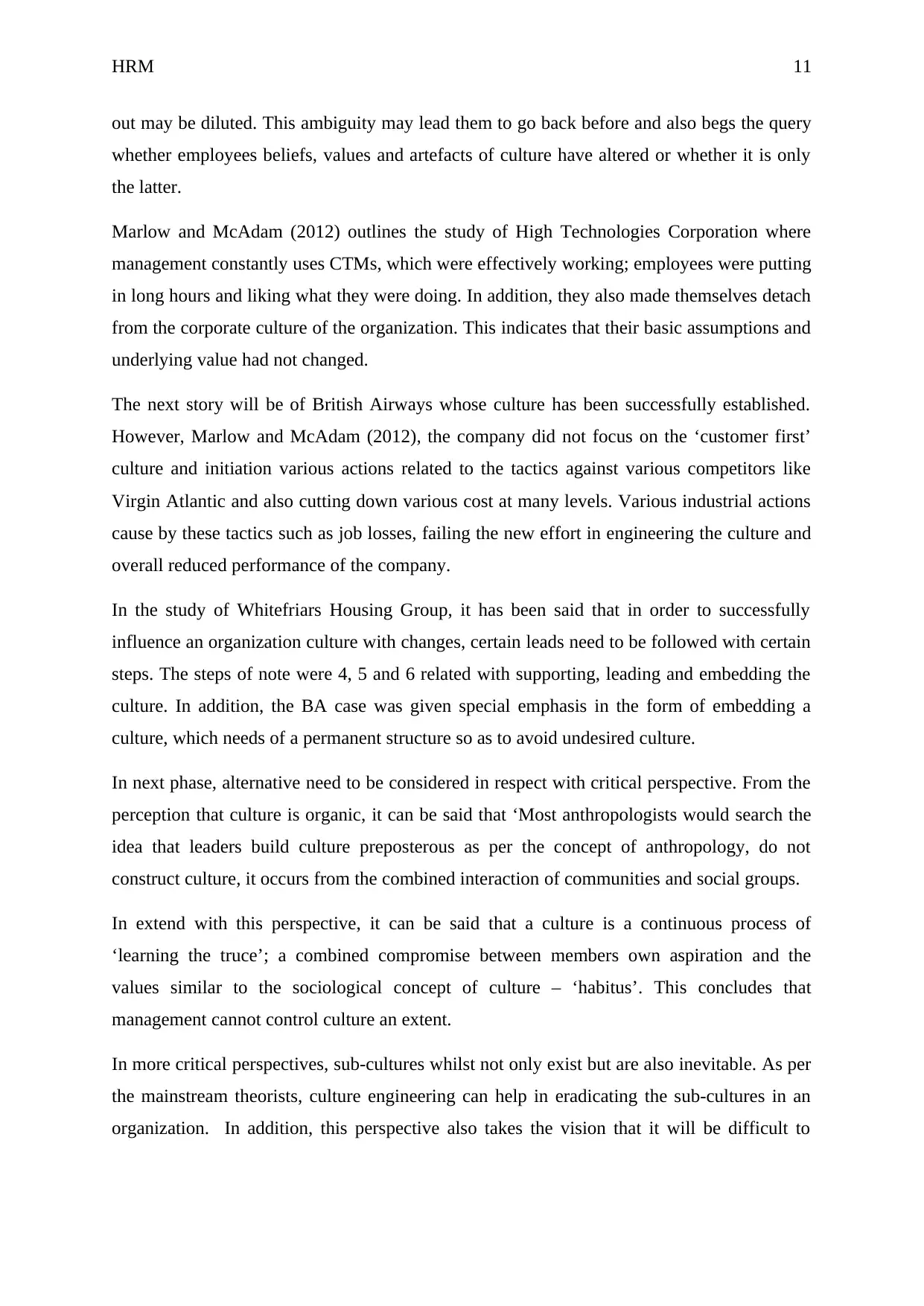
HRM 11
out may be diluted. This ambiguity may lead them to go back before and also begs the query
whether employees beliefs, values and artefacts of culture have altered or whether it is only
the latter.
Marlow and McAdam (2012) outlines the study of High Technologies Corporation where
management constantly uses CTMs, which were effectively working; employees were putting
in long hours and liking what they were doing. In addition, they also made themselves detach
from the corporate culture of the organization. This indicates that their basic assumptions and
underlying value had not changed.
The next story will be of British Airways whose culture has been successfully established.
However, Marlow and McAdam (2012), the company did not focus on the ‘customer first’
culture and initiation various actions related to the tactics against various competitors like
Virgin Atlantic and also cutting down various cost at many levels. Various industrial actions
cause by these tactics such as job losses, failing the new effort in engineering the culture and
overall reduced performance of the company.
In the study of Whitefriars Housing Group, it has been said that in order to successfully
influence an organization culture with changes, certain leads need to be followed with certain
steps. The steps of note were 4, 5 and 6 related with supporting, leading and embedding the
culture. In addition, the BA case was given special emphasis in the form of embedding a
culture, which needs of a permanent structure so as to avoid undesired culture.
In next phase, alternative need to be considered in respect with critical perspective. From the
perception that culture is organic, it can be said that ‘Most anthropologists would search the
idea that leaders build culture preposterous as per the concept of anthropology, do not
construct culture, it occurs from the combined interaction of communities and social groups.
In extend with this perspective, it can be said that a culture is a continuous process of
‘learning the truce’; a combined compromise between members own aspiration and the
values similar to the sociological concept of culture – ‘habitus’. This concludes that
management cannot control culture an extent.
In more critical perspectives, sub-cultures whilst not only exist but are also inevitable. As per
the mainstream theorists, culture engineering can help in eradicating the sub-cultures in an
organization. In addition, this perspective also takes the vision that it will be difficult to
out may be diluted. This ambiguity may lead them to go back before and also begs the query
whether employees beliefs, values and artefacts of culture have altered or whether it is only
the latter.
Marlow and McAdam (2012) outlines the study of High Technologies Corporation where
management constantly uses CTMs, which were effectively working; employees were putting
in long hours and liking what they were doing. In addition, they also made themselves detach
from the corporate culture of the organization. This indicates that their basic assumptions and
underlying value had not changed.
The next story will be of British Airways whose culture has been successfully established.
However, Marlow and McAdam (2012), the company did not focus on the ‘customer first’
culture and initiation various actions related to the tactics against various competitors like
Virgin Atlantic and also cutting down various cost at many levels. Various industrial actions
cause by these tactics such as job losses, failing the new effort in engineering the culture and
overall reduced performance of the company.
In the study of Whitefriars Housing Group, it has been said that in order to successfully
influence an organization culture with changes, certain leads need to be followed with certain
steps. The steps of note were 4, 5 and 6 related with supporting, leading and embedding the
culture. In addition, the BA case was given special emphasis in the form of embedding a
culture, which needs of a permanent structure so as to avoid undesired culture.
In next phase, alternative need to be considered in respect with critical perspective. From the
perception that culture is organic, it can be said that ‘Most anthropologists would search the
idea that leaders build culture preposterous as per the concept of anthropology, do not
construct culture, it occurs from the combined interaction of communities and social groups.
In extend with this perspective, it can be said that a culture is a continuous process of
‘learning the truce’; a combined compromise between members own aspiration and the
values similar to the sociological concept of culture – ‘habitus’. This concludes that
management cannot control culture an extent.
In more critical perspectives, sub-cultures whilst not only exist but are also inevitable. As per
the mainstream theorists, culture engineering can help in eradicating the sub-cultures in an
organization. In addition, this perspective also takes the vision that it will be difficult to
⊘ This is a preview!⊘
Do you want full access?
Subscribe today to unlock all pages.

Trusted by 1+ million students worldwide
1 out of 17
Related Documents
Your All-in-One AI-Powered Toolkit for Academic Success.
+13062052269
info@desklib.com
Available 24*7 on WhatsApp / Email
![[object Object]](/_next/static/media/star-bottom.7253800d.svg)
Unlock your academic potential
Copyright © 2020–2025 A2Z Services. All Rights Reserved. Developed and managed by ZUCOL.





